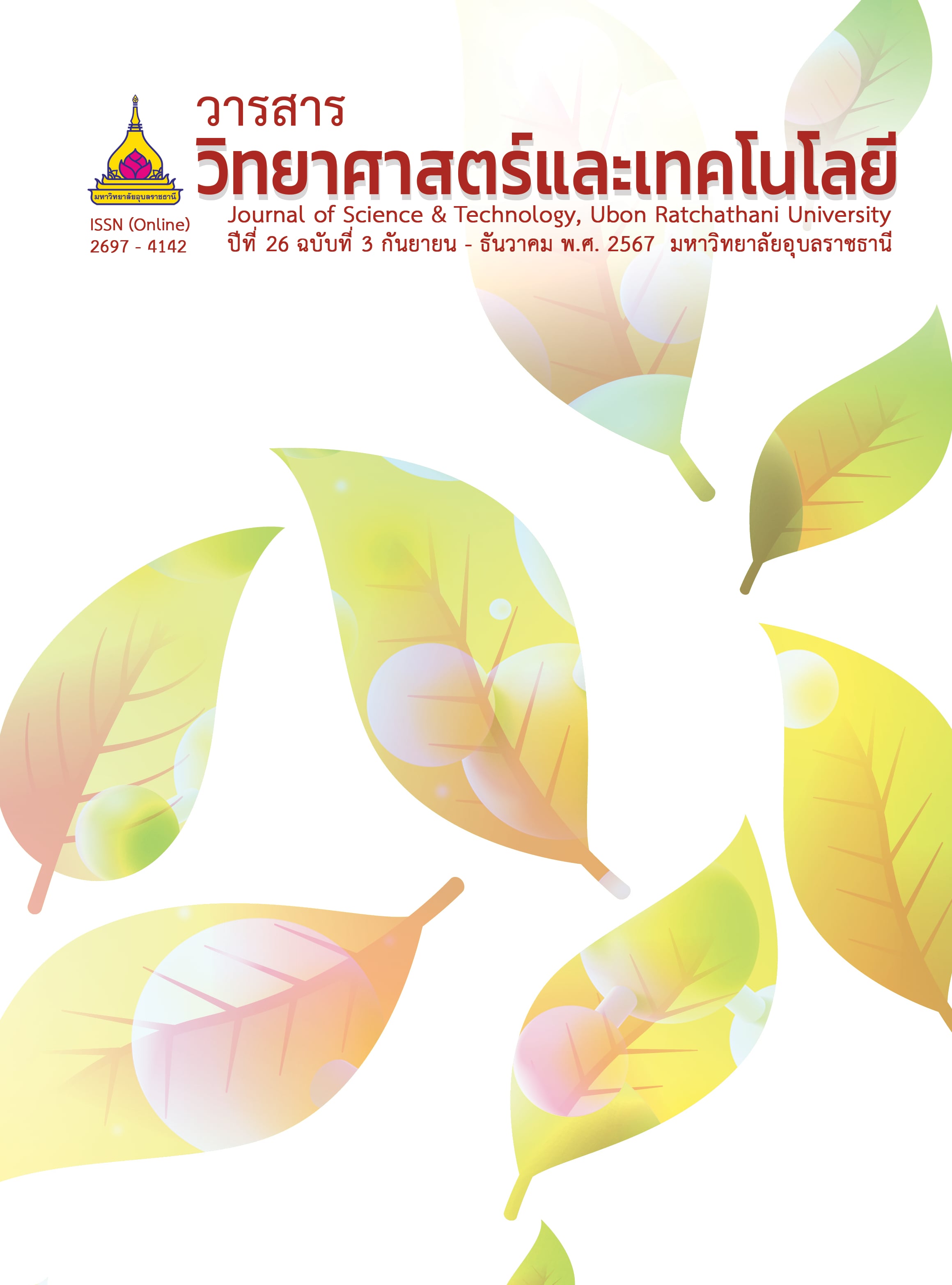การสังเคราะห์และการศึกษาสมบัติของวัสดุผสมซิงค์ออกไซด์/บิสมัทออกซีคลอไรด์ ที่มีความสามารถย่อยสลายสีโรดามีน บี ด้วยกระบวนเร่งปฏิกิริยาด้วยแสง
Main Article Content
บทคัดย่อ
งานวิจัยนี้มีวัตถุประสงค์เพื่อสังเคราะห์วัสดุผสมซิงค์ออกไซด์/บิสมัทออกซีคลอไรด์ (วัสดุผสม ZnO/BiOCl) ในอัตราส่วน 1:1, 1:2 และ 2:1 โดยน้ำหนัก และเพื่อศึกษาสมบัติของวัสดุผสมที่สังเคราะห์ขึ้น รวมทั้งศึกษาความสามารถของวัสดุผสมที่สังเคราะห์ขึ้น ในการย่อยสลายสีโรดามีน บี ด้วยกระบวนเร่งปฏิกิริยาด้วยแสง การสังเคราะห์วัสดุผสม ZnO/BiOCl ใช้วิธีการแผ่คลื่นไมโครเวฟ การศึกษาสมบัติของวัสดุผสม ZnO/BiOCl ที่สังเคราะห์ขึ้นใช้เทคนิคการเลี้ยวเบนของรังสีเอกซ์ (XRD) กล้องจุลทรรศน์อิเล็กตรอนแบบส่องกราดชนิดฟิลด์อีมิสชัน (FESEM) เทคนิคการกระจายพลังงานของรังสีเอกซ์ (EDX) เทคนิคฟูเรียร์ทรานฟอร์มอินฟราเรดสเปกโทรสโกปี (FTIR) และเทคนิคการวิเคราะห์หาค่าพื้นที่ผิวจำเพาะ (BET) ส่วนการย่อยสลายสีโรดามีน บี ด้วยกระบวนเร่งปฏิกิริยาด้วยแสงของวัสดุผสม ZnO/BiOCl ที่สังเคราะห์ขึ้นใช้เครื่องวัดค่าการดูดกลืนแสงแบบ UV-Vis spectrophotometer การวิเคราะห์วัสดุผสม ZnO/BiOCl ในทุกอัตราส่วนของ ZnO และ BiOCl ด้วยเทคนิคการเลี้ยวเบนของรังสีเอกซ์ พบพีคการเลี้ยวเบนที่แสดงเฟสเฮกซะโกนอลของซิงค์ออกไซด์และเตตระโกนอลของบิสมัทออกซีคลอไรด์ นอกจากนี้ยังพบว่าวัสดุผสม ZnO/BiOCl อัตราส่วน 1:1 โดยน้ำหนัก เป็นวัสดุผสมที่มีลักษณะเป็นแผ่น มีพื้นที่ผิวจำเพาะสูงสุด เท่ากับ 581.48 ตารางเมตรต่อกรัม และมีประสิทธิภาพในการย่อยสลายสีโรดามีน บี ดีที่สุด เท่ากับ 69.97 เปอร์เซ็นต์ ในเวลา 120 นาที ภายใต้สภาวะที่มีแสง
Article Details

อนุญาตภายใต้เงื่อนไข Creative Commons Attribution-NonCommercial-NoDerivatives 4.0 International License.
บทความที่ได้รับการตีพิมพ์เป็นลิขสิทธิ์ของ วารสารวิทยาศาสตร์และเทคโนโลยี มหาวิทยาลัยอุบลราชธานี
ข้อความที่ปรากฏในบทความแต่ละเรื่องในวารสารวิชาการเล่มนี้เป็นความคิดเห็นส่วนตัวของผู้เขียนแต่ละท่านไม่เกี่ยวข้องกับมหาวิทยาลัยอุบลราชธานี และคณาจารย์ท่านอื่นๆในมหาวิทยาลัยฯ แต่อย่างใด ความรับผิดชอบองค์ประกอบทั้งหมดของบทความแต่ละเรื่องเป็นของผู้เขียนแต่ละท่าน หากมีความผิดพลาดใดๆ ผู้เขียนแต่ละท่านจะรับผิดชอบบทความของตนเองแต่ผู้เดียว
เอกสารอ้างอิง
Yang, X. and et al. 2021. One-pot construction of robust BiOCl/ZnO p-n heterojunctions with semi-coherent interfaces toward improving charge separation for photodegradation enhancement. Nanoscale Advances. 3(16): 4851-4857.
Sombatsri, S. and et al. 2017. Biosorption of rhodamine B dyes using modified water hyacinth roots. RMUTP Research Journal. 11(2): 59-68. (in Thai)
Pirot, S. 2022. Preparation of zinc oxide nanoparticles for cancer treatment. Journal of Engineering Technology Access. 2(1): 22-34. (in Thai)
Bukhari, A. and et al. 2022. Catalytic degradation of MO and MB dyes under solar and uv light irradiation using ZnO fabricated using Syzygium cumini leaf extract. Zeitschrift für Physikalische Chemie. 236(5): 659-671.
Suthivatanakul, O. 2019. Dye Wastewater Treatment by Photocatalytic Process Using TiO2 Catalysts and Nanobubbles. M.Eng. Thesis, Rajamangala University of Technology Thanyaburi. (in Thai)
Jun-Qing, C. and et al. 2019. Study on highly efficient BiOCl/ZnO pn heterojunction: Synthesis, characterization and visible-light excited photocatalytic activity. Journal of Molecular Structure. 1183: 209-216.
Fu, Q. and et al. 2022. Constructing BiOCl/ZnO heterojunction from Bi-MOF for efficient photocatalytic degradation performance. Inorganic Chemistry Communications. 140: 109445.
Hong, J. and et al. 2022. Preparation of ZnO-BiOCl composite and its visible-light photocatalytic degradation of RhB. Journal of Physics: Conference Series. 2285: 1-5.
Liu, X. and et al. 2019. Facile Preparation of BiOCl/ZnO heterostructure with oxygen-rich vacancies and its enhanced photocatalytic performance. ChemistrySelect. 4(42): 12245-12251.
Zhang, Z. and et al. 2021. Synthesis of Ag loaded ZnO/BiOCl with high photocatalytic performance for the removal of antibiotic pollutants. Crystals. 11(8): 981.
Somrit, R. and et al. 2023. Effects of calcination temperature on physicochemical properties and antifungal activity of nano-zinc oxide prepared by sol-gel method. Journal of Science and Technology, Ubon Ratchathani University. 25(1): 72-80. (in Thai)
Maisang, W. and et al. 2020. Microwave-assisted hydrothermal synthesis of BiOBr/ BiOCl flowerlike composites used for photocatalysis. Research on Chemical Intermediates. 46: 2117-2135.
Loka, C. and Lee, K.S. 2022. Enhanced visible-light-driven photocatalysis of Ag/Ag2O/ZnO nanocomposite heterostructures. Nanomaterials. 12(15): 2528.
Mansor, E.S., Geioushy, R.A. and Fouad, O.A. 2021. PANI/BiOCl nanocomposite induced efficient visible-light photocatalytic activity. Journal of Materials Science: Materials in Electronics. 32: 1992-2000.
De Peres, M.L. and et al. 2019. Zinc oxide nanoparticles from microwave-assisted solvothermal process: Photocatalytic performance and use for wood protection against xylophagous fungus. Nanomaterials and Nanotechnology. 9: 1-8.
Lopez-Velazquez, K. and et al. 2021. Synthesis of Fe–BiOBr–N by microwave-assisted solvothermal method: Characterization and evaluation of its photocatalytic properties. Materials Science in Semiconductor Processing. 123: 105499.
Jayarambabu, N. and et al. 2014. Germination and growth characteristics of mungbean seeds (Vigna radiata L.) affected by synthesized zinc oxide nanoparticles. International Journal of Current Engineering and Technology. 4(1): 3411-3416.
Seddigi, Z.S. and et al. 2017. Facile synthesis of light harvesting semiconductor bismuth oxychloride nano photo-catalysts for efficient removal of hazardous organic pollutants. PLoS One. 12(2): 1-19.
Rohilla, S. and et al. 2021. Excellent UV-light triggered photocatalytic performance of ZnO.SiO2 nanocomposite for water pollutant compound methyl orange dye. Nanomaterials. 11(10): 2548.
Ntuli, T.D. and et al. 2023. Improved adsorption and photocatalytic degradation of methyl orange by onion-like nanocarbon/TiO2 nanocomposites. Applied Sciences. 13(8): 5125.
Nabavi, N., Peyda, M. and Sadeghi, G. 2017. The photocatalytic kinetics of the methyl orange degradation in the aqueous suspension of irradiated TiO2. Journal of Human, Environment and Health Promotion. 2(3): 154-160.


